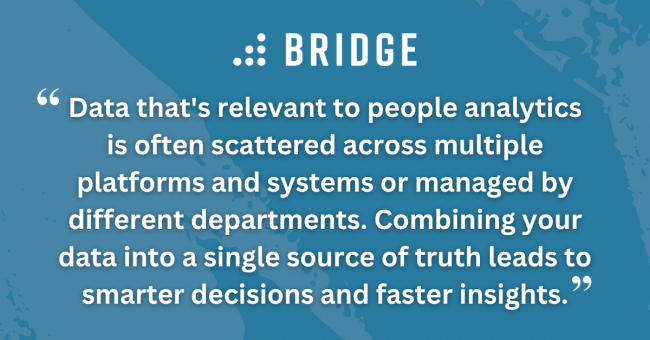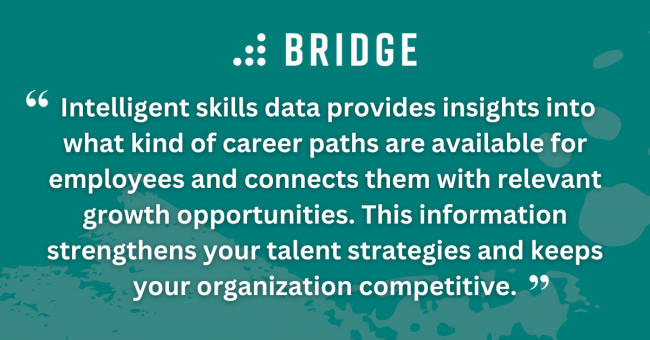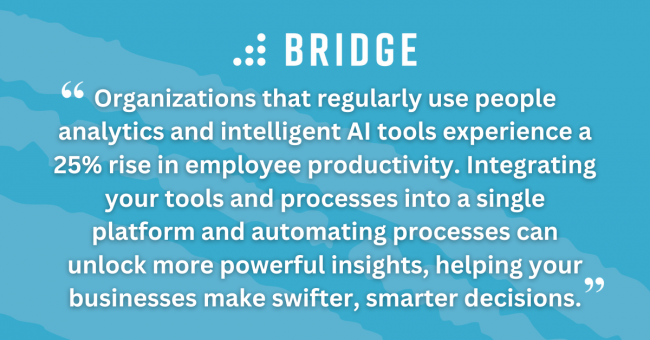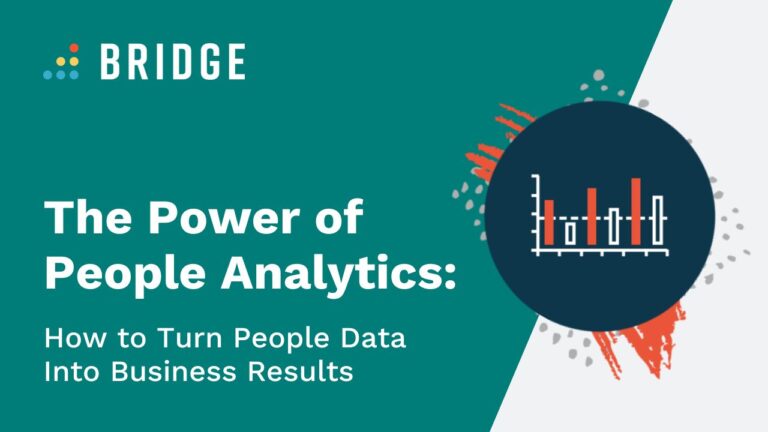Investing in the existing workforce and developing their skills is a top strategic priority for leaders with their sights set firmly on future business growth.
This focus is reflected in budget decisions, as nearly 50% plan to increase spending on HR technologies and talent development, according to research compiled by Gartner.
For talent investments to deliver maximum impact, strategic decisions must be informed by data that helps teams analyze impact and optimize outcomes.
People analytics can use HR metrics to drive impactful business results and maximize the impact of training and development programs.
What Is People Analytics?
People analytics—sometimes referred to as HR analytics or workforce analytics—is the practice of collecting and analyzing large-scale organizational data to improve talent management strategies and processes. It’s about making decisions backed by real-time data, not opinions.
Reports will give you data, but this gives only a static snapshot of what’s going on. People analytics pulls data to help inform teams about why something’s happening and what to do next. If your strategy is the map, people analytics is the compass that helps your organization navigate toward its destination.
The beauty of analytics is that it reduces human bias and improves the precision and speed of decision-making by identifying what your people and organization need based on the data at hand. It’s another way of listening to your employees and, in turn, understanding what they’re saying (even if they haven’t “said” anything at all).
By transforming metrics into actionable insight, you can spot previously unforeseen trends, preempt problems, and make smarter decisions across all areas of the organization.

FIND OUT HOW TO GATHER EMPLOYEE ENGAGEMENT METRICS | ‘How to Create an Employee Engagement Action Plan That Turns Insights Into Results’
4 People Analytics Questions That Transform Disjointed HR Metrics Into Actionable Business Insights
Tracking and analyzing key HR metrics means you can see what’s happening within your organization and enhance your processes and strategies as a result.
Analyzing the effectiveness of HR metrics and interpreting this data gives you the context to make better informed decisions.
Use the following questions to guide your process:
1) What’s the Business Goal?
People analytics works to connect your talent strategies with business goals, improve processes, and justify decisions.
The first step to better decision-making is to understand what your organization is trying to accomplish and how to measure success. Defining this will help you ask the right questions and in turn, understand what to look for in the data.
2) What Employee Data Already Exists?
Start with the data that already exists within your systems. Once analyzed and distributed in an engaging way, it can lead your organization toward creating meaningful impacts.
Using advanced reporting and analytics capabilities can uncover unseen aspects of employee behavior, motivations, and potential. This information can then be connected to key areas and leveraged appropriately.
Your organization is likely to already collect the following useful data:
- Personal details and demographics
- Tenure and turnover histories
- Employee feedback
- Performance and talent reviews
- Learning and assessment scores
- Absence and leave rates
- Employee advancement and development records
DO MORE WITH YOUR DATA | ‘The Power of Learning Analytics to Drive Decisions and Growth’
3) Where’s Your Data Stored?
One of the main challenges HR professionals face when implementing people analytics is a lack of data infrastructure.
Relevant data is often scattered across multiple platforms and systems or managed by different departments. This means it might be tough to connect data points, and you could miss important insights and results.
To get the most out of your metrics, they should be easy for stakeholders to access, analyze, and share.
Combining your data into a single source of truth leads to smarter decisions and faster insights. An all-in-one platform that connects employee learning, performance, skills, and engagement data puts the puzzle pieces together and gives you more powerful and actionable reports.
Organizations typically pull their people analytics data from some or all of the following locations:
- HRIS or HCM
- Learning Management System
- Performance Management System
- Workplace intranet
- Employee engagement and pulse survey results
4) Is Your Data High Quality?
High-quality data is a must. It should be easy to access, relevant to your organization’s shared goals, and easily interpreted by all of your stakeholders.
Data should be current, come from internal sources, and be free from error and inconsistencies. Any gaps or inaccuracies will need to be addressed before proceeding.
FURTHER READING | ‘How to Pitch HR Tech to Your IT Team’

6 Ways to Leverage People Analytics for Better Business Performance
Collecting information about your people allows you to track and monitor key metrics. However, these metrics won’t answer strategic questions by themselves. With sophisticated analytics and tracking, you can go a step further to correlate metrics with organizational goals and strategies.
If it’s managed well, the biggest challenge is often what to do with all the data. What does it mean for the business, and what does it tell you? That’s where analytics comes in, as it can provide insight that leads to powerfully data-driven actions.
Here are six effective ways to apply people analytics:
1) Mobilize Talent and Make Strategic Decisions
By providing actionable insights into your data and connecting them to organizational goals, you can predict change, anticipate future talent needs, and create learning programs to develop skills and distribute knowledge.
These insights also enable you to be nimble with macroeconomics in the face of a downturn, proactively address and prepare for any issues, and give the most suitable work to the right people based on their skills.
People analytics can inform how you:
- Onboard and deploy talent to anticipate emerging skills gaps and future business needs
- Use your current employee demographics to identify untapped potential and connect employees with career development opportunities.
- Create succession plans, onboard employees, and redeploy talent for future roles
EXPLORE MORE WAYS TO INCREASE ORGANIZATIONAL AGILITY | ‘How AI Can Power Talent Management’
2) Improve Employee Retention
HR data can reveal why people leave your organization and what makes them choose to stay.
Addressing and improving the factors that cause turnover can improve the employee experience and preempt the causes of churn, creating a happier, more productive workforce.
People analytics can help you to:
- Identify departments or areas of the business at greater risk of leaving based on engagement surveys and one-on-ones
- Predict the employees most likely to leave based on factors such as age, tenure, and access to development opportunities
- Anticipate future hiring needs based on skills demand and business priorities
3) Boost Diversity, Equity, and Inclusion Efforts
People analytics plays a role in creating a fair, supportive culture in which your people feel heard.
By analyzing your DE&I metrics, you can identify gaps and implement strategies to foster a more inclusive workplace and culture.
You can use this data to:
- Spot any implicit bias in existing processes or communications
- Ensure pay equity based on skills, responsibilities, and performance rather than solely on job title
- Measure diversity of teams across the organization to encourage different perspectives
4) Enable Skills Development and Growth
Intelligent skills data provides insights into what kind of career paths are available for employees and connects them with relevant growth opportunities. This information strengthens your talent strategies and keeps your organization competitive.
People analytics can be used to personalize learning and development opportunities and suggest career paths within the company based on existing and desired skills. This data is delivered in real-time and personalized to each learner's goals.
People analytics allows you to:
- Match people with relevant learning and skills communities to enable growth and fill skills gaps
- Recommend learning tailored to individual development goals and account for learning preferences
- Connect employee learning with business performance to identify in-demand skills
MORE ABOUT SKILLS DEVELOPMENT | ‘How to Build a Job Architecture With AI-Assisted Skills Matching’
5) Inform Performance and Talent Reviews
People analytics does a good job giving employees a sense of purpose, ensuring they feel heard and part of the broader purpose of the team.
A transparent and fair performance culture that’s based on continuous conversation empowers your people to be their best and gives you a comprehensive view of how they’re progressing and feeding into goals in real time.
People analytics can be used to:
- Collect feedback from multiple sources and use objective evaluation scores to reduce the risk of bias during performance reviews
- Connect employees with in-the-moment feedback from peers, coaches, and managers and help them overcome challenges in a timely manner
- Identify high-performing employees and those most closely aligned with organizational goals
POWER UP YOUR TALENT REVIEWS WITH THESE INSIGHTS | ‘Rethinking the 9 Box Talent Review’
6) Drive Employee Engagement and Wellness
When you connect your data, you get to the heart of what employee engagement looks like within your organization and what metrics you should track.
Employee engagement surveys must adapt to changing workforce needs and ask the questions that garner the right answers.
People analytics can help you to:
- Find the top drivers of employee engagement and predict what actions will lead to the most significant improvements
- Look for specific departments or demographics with strong or weak engagement scores and absentee rates
- Check employee benefit usage and enrollment versus employee engagement

HERE ARE THE QUESTIONS YOU SHOULD BE ASKING | ‘How Can Smart Stay Interview Question Selections Boost Employee Retention?’
Why You Need the Right Tools and Technologies to Support Your People Analytics Strategy
Basic metrics can provide surface-level insights such as turnover rate, but to predict and understand employee behavior, your models need to sort and generate recommendations and decisions. When you unite a connected and data-driven organizational culture with an intuitive platform, you get the most out of this data.
McKinsey research shows how organizations that regularly use people analytics and intelligent AI tools experience a 25% rise in employee productivity and a 50% decrease in turnover.
Integrating your tools and processes into a single platform and automating reporting processes can unlock more powerful insights, helping your businesses make swifter, smarter decisions and revealing data points that aren’t always easy to spot.
While gathering and cleaning up data used to be a time-consuming process, the right tools can automate, analyze, and generate reports in a fraction of the time. This helps you make faster decisions while providing insight—not just data collection.
LEARN MORE | ‘What’s the Role of AI in Your Talent Management Strategy?’
Turn Insights Into Results With Bridge Analytics
Combine your people data into an integrated, easy-to-use platform with Bridge. Collect, measure, and connect the results to strategic objectives to show the impact of your efforts.
Automated reporting and customizable analytics make it simple to share data, interpret results, and generate reports customized to your organization’s needs.




